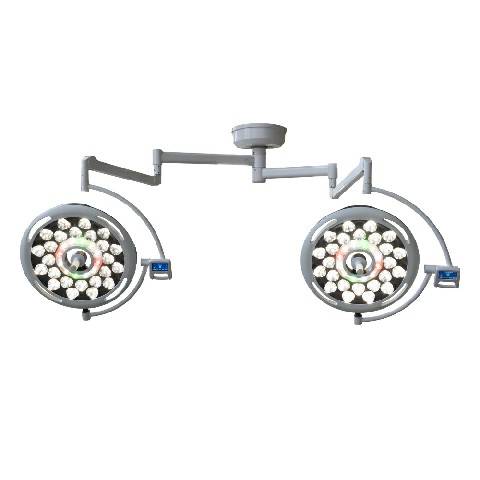Dirección
304 North Cardinal St.
Dorchester Center, MA 02124
Horas laborales
Lunes a viernes: 7:00 a. M. - 7:00 p. M.
Fin de semana: 10 a. M. - 5 p. M.
¡Bienvenido a mi blog!
Antes de profundizar en el contenido, me encantaría que te unas a mí en mis plataformas de redes sociales, donde comparto más información, interactúo con la comunidad y publico actualizaciones. Puedes conectarte conmigo de la siguiente manera:
Facebook:https://www.facebook.com/profile.php?id=100071234835011
LinkedIn:https://www.linkedin.com/company/74943205/admin/dashboard/
YouTube:www.youtube.com/@shandongexpertmedicalequip4695
TikTok:www.tiktok.com/@expertmedical
Ahora, comencemos nuestro viaje juntos. Espero que el contenido que se incluye aquí te resulte interesante, interesante y valioso.

Surgical overhead lights, also known as surgical lights or operating room lights, are designed to provide intense, shadow-free illumination during surgical procedures. Unlike standard lighting, these specialized fixtures offer a focused and adjustable light source, allowing surgeons to visualize intricate anatomical details with clarity. The quality of surgical overhead lighting directly impacts the surgeon’s ability to perform precise maneuvers, reducing the risk of errors and improving patient safety. In modern ORs, advanced surgical overhead light systems incorporate cutting-edge technologies to enhance visibility, minimize heat generation, and promote a comfortable working environment for the surgical team.
Several key features distinguish high-quality surgical overhead lights from conventional lighting systems. These features contribute to improved surgical precision, reduced surgeon fatigue, and enhanced overall OR efficiency.
The intensity of illumination, measured in lux, is a crucial factor in surgical lighting. Surgical overhead lights must provide sufficient light to illuminate the surgical field without creating glare or excessive heat. Color temperature, measured in Kelvin (K), is another important aspect of light quality. Ideally, surgical lights should emit a cool, white light (around 4000-5000K) that accurately renders tissue colors, allowing surgeons to distinguish between different anatomical structures.
Shadows can significantly hinder surgical visibility, especially in deep cavities. Effective surgical lights utilize multiple light sources and advanced optical designs to minimize shadows and provide uniform illumination throughout the surgical field. This shadow reduction is crucial for procedures involving deep incisions or minimally invasive techniques. Depth of illumination refers to the light’s ability to penetrate deep into the surgical cavity, ensuring adequate visibility even in challenging anatomical locations.
Surgical overhead lights should be ergonomically designed to allow for easy positioning and adjustment by the surgical team. The light head should be lightweight and maneuverable, allowing for precise aiming of the light beam. Adjustable focus and light field size are also important features, enabling surgeons to customize the illumination according to the specific requirements of the procedure.
Traditional surgical lights often generated significant heat, which could be uncomfortable for the surgical team and potentially damage delicate tissues. Modern surgical lights utilize LED technology, which produces significantly less heat and consumes less energy than conventional light sources. This improved heat management contributes to a more comfortable OR environment and reduces operating costs.


Different types of surgical overhead lights cater to specific surgical needs and OR configurations.
Ceiling-mounted surgical lights are the most common type, offering flexibility in positioning and a wide range of adjustment options. They are typically suspended from the ceiling on articulating arms, allowing for precise placement of the light head over the surgical field.
Mobile surgical lights are portable and can be easily moved between different operating rooms or used in areas where ceiling mounting is not feasible. They are often used for minor procedures or in emergency situations.
Surgical headlights are worn by the surgeon, providing direct illumination of the surgical field. They are particularly useful for procedures requiring close-up visualization or in situations where access is limited.









High-quality surgical overhead lighting has a profound impact on surgical outcomes and the overall efficiency of the OR.
Adequate illumination is essential for surgeons to perform precise maneuvers and minimize the risk of surgical errors. Clear visualization of anatomical structures, facilitated by effective surgical overhead lights, contributes to improved surgical accuracy and reduced complications.
Poor lighting conditions can lead to eye strain, fatigue, and decreased concentration among surgical staff. High-quality surgical overhead lights, with their optimized illumination and ergonomic design, help reduce these issues, allowing surgeons to maintain focus and perform at their best.
Efficient lighting systems streamline the surgical workflow, reducing the need for constant adjustments and allowing the surgical team to focus on the procedure. This improved efficiency contributes to shorter operating times and better utilization of OR resources.
Selecting the right surgical overhead light system is a critical decision that requires careful consideration of several factors.
Different surgical specialties have varying lighting requirements. For example, neurosurgery requires extremely precise illumination and excellent shadow reduction, while general surgery may benefit from a larger light field and greater depth of illumination.
The size and configuration of the OR will influence the type and placement of surgical overhead lights. Ceiling height, available mounting points, and the layout of other OR equipment must be considered.
The initial cost of surgical overhead lights is an important consideration, but it’s equally important to factor in long-term costs such as energy consumption, maintenance, and replacement parts. LED technology offers significant cost savings over traditional light sources in the long run.
The field of surgical overhead lighting continues to evolve, with ongoing advancements in technology aimed at further improving surgical outcomes.
LED technology has revolutionized surgical lighting, offering significant advantages over traditional halogen or incandescent lights. LEDs are more energy-efficient, generate less heat, have a longer lifespan, and provide a more consistent light output.
Modern surgical overhead lights are increasingly being integrated with imaging and navigation systems, providing surgeons with real-time visualization and guidance during complex procedures. This integration enhances surgical precision and reduces reliance on traditional anatomical landmarks.
Future trends in surgical lighting include further advancements in LED technology, improved integration with other OR systems, and the development of more ergonomic and user-friendly designs. The focus will continue to be on optimizing illumination, minimizing heat generation, and enhancing the overall surgical experience.

It’s crucial to understand the technical specifications of surgical overhead lights when making purchasing decisions. Here’s a table outlining common specifications and their significance:
| Especificación | Descripción | Significance |
|---|---|---|
| Illumination (Lux) | The amount of light emitted by the light source, measured in lux. | Higher lux values indicate brighter illumination. The required lux level varies depending on the surgical specialty. |
| Temperatura de color (K) | The color of the light emitted by the light source, measured in Kelvin. | Affects color rendering and the surgeon’s ability to distinguish between different tissues. A color temperature of 4000-5000K is generally preferred. |
| Índice de reproducción cromática (CRI) | A measure of how accurately the light source renders colors compared to natural light. | A higher CRI indicates better color accuracy. A CRI of 90 or higher is desirable for surgical lighting. |
| Diámetro del campo de luz | The diameter of the illuminated area on the surgical field. | Should be adjustable to accommodate different surgical procedures and incision sizes. |
| Profundidad de iluminación | The distance over which the light maintains a consistent intensity. | Important for procedures involving deep cavities. |
| Reducción de sombras | The ability of the light to minimize shadows cast by instruments or the surgeon’s hands. | Crucial for maintaining clear visibility during surgery. |
Investing in high-quality surgical overhead lights is a crucial decision for any healthcare facility. The benefits of optimized illumination, reduced surgeon fatigue, and enhanced OR efficiency translate to improved surgical outcomes, reduced complications, and better patient care. By carefully considering the key features, types, and specifications of surgical overhead lights, healthcare professionals can make informed decisions that contribute to a safer and more effective surgical environment. The continuous advancements in surgical overhead light technology promise even greater improvements in the future, further enhancing the capabilities of the surgical team and ultimately benefiting patients.
¿Con qué frecuencia debería? surgical overhead lights be inspected and maintained?
Regular inspection and maintenance are essential to ensure optimal performance and safety. Manufacturers’ recommendations should be followed, but typically, annual inspections by qualified technicians are recommended.
What are the advantages of LED surgical overhead lights over traditional lights?
LED surgical overhead lights offer several advantages, including lower energy consumption, reduced heat generation, longer lifespan, and more consistent light output.
Como hacer surgical overhead lights ¿Contribuir a la seguridad del paciente?
Surgical overhead lights contribute to patient safety by providing optimal illumination, reducing the risk of surgical errors, and minimizing surgeon fatigue.
Are there specific cleaning procedures for surgical overhead lights?
Yes, specific cleaning procedures should be followed to maintain the hygiene and functionality of surgical overhead lights. Manufacturers’ instructions should be consulted for detailed cleaning protocols.
How are surgical overhead lights integrated with other OR equipment?
Modern surgical overhead lights can be integrated with imaging systems, navigation systems, and other OR equipment through digital interfaces and control systems.
